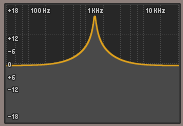There is no one way to use an EQ, but there are a few common techniques that people use to EQ, and they can be applied on most sources.
First a few general tips:
- Make small changes. EQs are not magic, and they will not instantly improve your recording. They are best for making small tweaks.
- Be careful with boosting. It's oftentimes better to attenuate first and then increase the overall gain if necessary.
- Try things. Try whatever you want, and learn from it. If you want something to sound in a specific way, that's completely fine. Don't let random people on the Internet tell you what to do 😉
Now, the techniques:
Cutting / Filtering
You may have heard about something like a high-pass or low-cut filter. This concept can be achieved by taking a EQ band and positioning it to "cut" only the lowest frequencies.
If you are recording a violin for example, their lowest string G is just around 190 Hz. Any information below 190 Hz is likely not useful, so you can simply cut it out. If you repeat the same concept on every instrument in the mix, you'll likely increase the total clarity.

You can of course do the inverse to achieve a low-pass filter, but
this is not as common (especially not with acoustic instruments) as it
results in more of an effect.
Cleaning
You mention the "bad" frequencies. What you are referring to are frequencies that are especially resonant, compared to the rest of the spectrum. The reason the "bad" frequencies occur can be due to the room they were recorded in, the instrument itself, the playing technique, or a number of other reasons.
The act of removing (attenuating) these frequencies is commonly referred to as cleaning.
Pick the most narrow Q your EQ will allow, max out the gain and scan through the spectrum until you find especially resonant frequencies.

Once you find the most resonant ones, widen your Q and attenuate the problematic frequency and its near range with your gain set to something like -1 to -3 dB.

Note that the resonant frequencies will probably reoccur one octave
above the last, so it can be useful to start in the low range, and
then go up by octaves (double the frequency) using a lower gain each time
As for specific values, I gave you a general idea of some of it, but really as I said in the beginning, there are no one-size-fits-all solution in EQing. Play around with different values and see what happens. The most important tool at the end of the day, is your ears.
If it sounds good, it's good.



